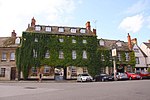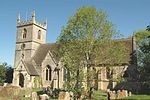Woodstock, Oxfordshire

Woodstock is a market town and civil parish, 8 miles (13 km) north-west of Oxford in West Oxfordshire in the county of Oxfordshire, England. The 2011 Census recorded a parish population of 3,100.Blenheim Palace, a UNESCO World Heritage Site, is next to Woodstock, in the parish of Blenheim. Winston Churchill was born in the palace in 1874 and buried in the nearby village of Bladon. Edward, elder son of King Edward III and heir apparent, was born in Woodstock Manor on 15 June 1330. In his lifetime he was commonly called Edward of Woodstock, but is known today as the Black Prince. In the reign of Queen Mary I, her half-sister Elizabeth was imprisoned in the gatehouse of Woodstock Manor.
Excerpt from the Wikipedia article Woodstock, Oxfordshire (License: CC BY-SA 3.0, Authors, Images).Woodstock, Oxfordshire
Oxford Street, West Oxfordshire
Geographical coordinates (GPS) Address Nearby Places Show on map
Geographical coordinates (GPS)
| Latitude | Longitude |
|---|---|
| N 51.847777777778 ° | E -1.3541666666667 ° |
Address
The Marlborough Arms
Oxford Street 26
OX20 1TS West Oxfordshire
England, United Kingdom
Open on Google Maps








